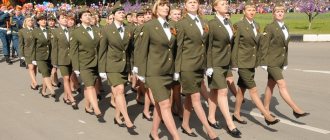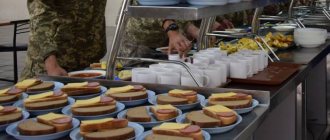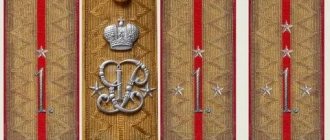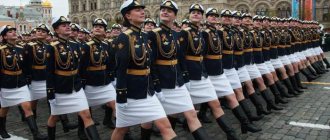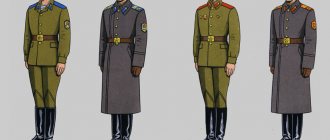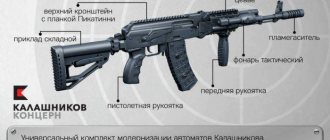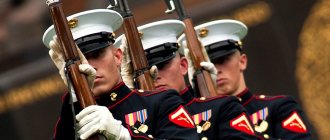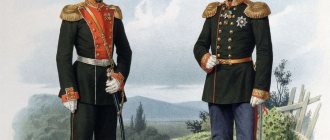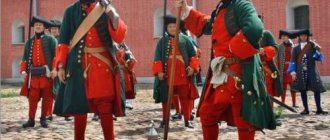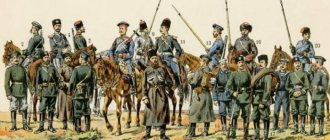The soldier's uniform has undergone many modifications throughout the history of the Russian army. Not only its appearance changed, but also its practical component. The development of kits for military personnel is carried out by professional technologists, taking into account all the nuances of military life.
VKPO uniform for military personnel today is an integral attribute of a soldier of the Armed Forces of the Russian Federation. What it looks like, what practical and quality characteristics it has, and what elements it includes - read on.
Additional information about the new office uniform in the army
According to the Order of the Ministry of Defense, wearing uniforms, departmental and heraldic insignia is an obligation not only for military personnel, but also for federal government civilians working in military departments and departments, the General Staff, and the Ministry.
The new uniform is identical for military personnel and civilian personnel of the Russian Armed Forces in terms of cut and quality of fabric used. Distinctive features are insignia: army shoulder straps, buttonholes and other chevrons, heraldic insignia for federal government civil servants.
Sleeve insignia for civil servants correspond to a specific department (department), and are placed on the right sleeve of a jacket or shirt. Breast badges for civil servants reflect: the right-sided ones - belonging to the Armed Forces, have the inscription “Ministry of Defense of Russia”, the left-sided ones - the surname and initials.
For civilian personnel with a class rank, the uniform is distinguished by the silver (gray-white) color of the device, for military personnel - the gold (yellow) color of the device. Civil servants of the RF Armed Forces with the rank of State Counselor are required to wear shoulder straps on their jackets, winter uniforms and shirts.
The location and appearance of buttonholes on the office uniform of ground forces officers
Where are uniforms issued to conscripts?
The assembly point is the first army place where all conscripts go. There, a second examination by a doctor takes place, fingerprints are taken and uniforms are issued to future soldiers.
This is what the process of dressing conscripts in military uniform at the assembly point looks like
Civilian clothing is packed in special bags, which are sent home to relatives.
Conscripts receive for their use:
- underwear (T-shirts and boxer shorts, insulated underwear in winter; sailors receive vests);
- trousers and jacket (insulated in winter);
- waist belt made of textile material;
- sleeve insignia with the national flag and a stylized double-headed eagle;
- "Russian Armed Forces" chest patch;
- a cap (in winter - a hat);
- lace-up boots (leather with inserts made of special fabric) with stable rubberized soles;
- socks (in winter - insulated);
- a set for everyday hygiene procedures (toothbrush and paste, soap and shampoo, shaving cream with tools, napkins and a towel, sponge for shoe care, thread with a needle, comb);
- SIM card for your phone.
Below we will discuss the various types of uniform provision for young soldiers, depending on the place of service of the Defender of the Fatherland.
What does it represent?
The abbreviation has been known to every soldier since Soviet times. Only before it sounded like “VKBO” - an all-season set of basic uniforms. The updated uniform is called “VKPO” (all-season field uniform set). Military technologists are engaged in improvement. This process began after comparing domestic samples with foreign ones.
Our models were significantly inferior in terms of quality and practical parameters, taking this into account the Ministry of Defense of the Russian Federation decided to develop new uniforms. More precisely, the basic set was supplemented with missing items and modernized.
Today, modern VKPO has 28 items (including 3 pairs of shoes). The main feature is multi-layering, i.e. the presence of several levels, layers, combinations that can be combined in different ways (depending on climatic conditions, the specifics of the actions performed).
THIS IS INTERESTING! Because of this “multi-layered” shape, people began to call the form “cabbage”; the word quickly spread and took root among people, which is still relevant today. Therefore, if you hear mention of “cabbage” in a soldier’s vocabulary, you should know that we are talking about VKPO.
And this is how it will look on soldiers:
In a fleece jacket In a windbreaker
In a demi-season suit In a wind- and moisture-proof suit
In an insulated vest
In a summer suit
In a warm suit (with a ski hat)
Summer suit + summer cap + boots with high tops for temperatures from +15°C and above 1. Explanations on changing the shape of pockets from manufacturers: – Why were the pockets made horizontal on a summer jacket, and not at an angle, as was originally the case? – This was the wish of those who participated in the experimental wear. They said they found it more comfortable when the pockets were positioned horizontally. 2. 3. 4. The cut of the shape allows you to move your arms more freely, without fear that it will “crack” at the seams 5. There are places for protective inserts on the elbows and knees. The inserts themselves are not included in the kit. Why is this, VKBO manufacturers answer: – What about the protection of elbows and knees? Why are there spaces for protective inserts, but no inserts themselves? – There is some problem here with the fact that the uniform itself goes through the clothing supply line, and knee pads and elbow protection are purchased through the RAV service. When the Ministry of Defense resolves these issues among themselves, we will be happy to produce the necessary protective equipment. But for now, only the clothing service of the Russian Ministry of Defense issues orders to us. 6. Initially, the creators intended a stand-up collar, but the Ministry of Defense decided to return to a more traditional version with a turn-down collar. So the military personnel will walk like this 7. Removable lapel badges will be placed on Velcro on the collar, which again was the wish of the Ministry of Defense. The military nevertheless decided to abandon collar guards. 8. VKBO uses YKK zippers and Velcro textile fasteners (aka Velcro) 9. The jacket of the summer suit has not undergone any other significant changes, only a pocket has appeared on the inside left side 10. Trousers for the summer suit. Can be tied with a tie cord. In addition, the belt loops were expanded and enlarged, so that now a waist belt can be threaded into the trousers 11. The appearance of the trousers has changed somewhat, the side pockets at the bottom, previously intended for individual dressing bags, have disappeared 12. Pocket on the thigh 13. “Brakes” are now made of elastic fabric, no problems with “sharply bend your leg = break the brake” 14. 15. Summer suit + windbreaker jacket 16. 17. 18. 19. A piece of spare material. To patch the hole, the soldier will only have to work a little with an iron 20. There are zip ties on both sides from the bottom 21. Since the shape of the stripes and chevrons is different, the area for attaching them is specially made with a reserve 22. The zippers on the windbreaker are double-sided 23. 24. Summer cap. Finally, we got rid of the metal cockade 25. To store documents while crossing water obstacles, the cap has such a “pocket” 26. Long, lightweight, moisture-wicking underwear (unfortunately, I only photographed the top) 27. You can also use moisture-wicking underwear in the summer lightweight short 28. 29. Boots with high tops for temperatures from +15°C and above 30. – Why are the boots black and not protective? – Black boots are traditional for our army. In addition, there was no order from the Ministry of Defense to make shoes in a different color. You can offer other options yourself only if something similar from the materials is on stream. A rough example. Dyeing five meters of fabric in a certain color is only possible by hand (and only in one tone), because
for production you need a minimum batch, for example, 5 thousand, or even better, 10 thousand meters (this is especially important for camouflage fabrics). With industrial dyeing, there is a problem with selling the fabric produced.
For a prototype, you need to take 5 meters, even 200 meters, and the rest - you need to look for somewhere to attach it. Those. we freeze funds. For business this is not the most suitable option. Hence the desire to receive at least some wishes first. In addition, to produce samples you need to have a separate experimental production, and this is also an additional cost 31. Windproof suit + demi-season cap + high-top boots for temperatures from -10 to +15°C. In the final version, the Ministry of Defense decided to abandon the demi-season cap and instead there will be the same summer cap 32. With a hood 33. If previously the hood could be folded into a collar, now, at the request of the minister, this option has been removed 34. The zipper is securely blocked 35.
VKPO - review of the All-Season Field Uniform Set for military personnel of the Russian Armed Forces
To create a domestic all-season field uniform or an all-season field uniform set (VKPO) for the armed forces of the Russian Federation, foreign analogues were carefully studied. BTK group specialists took part of the technology for making military uniforms from foreign copies. However, having decided to save on costs, they used materials of average quality. It is difficult to find the required information about the technologies and fabrics used in production. But we will try to give a little information on them.
What elements does VKPO underwear consist of:
Layer 1. Sweat-wicking underwear. It includes a pair of short and long sets of underwear. Manufacturer's material: 100% synthetic fabric. Undoubtedly, it is significantly worse than the American equivalent. It does not cope with sweat removal as well as American brands. But overall it's quite decent. VKPO short underwear will cost approximately 400 rubles per set. The price of a long set of VKBO underwear will be about 800 rubles. Since 2017, VKPO underwear has been produced from cotton.
Layer 2. Fleece underwear. This type should fit the figure well. The quality of fleece underwear is low. The reason is that it is made of 93% polyester and 7% elastane. This is indicated on the manufacturer's label. After six months of constant wear, the product partially loses its thermal insulation properties. There is also slight discomfort when wearing it. The advantage over foreign analogues lies in the cost of the clothes presented. The cost of the set is from 1500 rubles. What is a competitive offer on the market.
Yes, thermal underwear from the manufacturer Polartec lasts twice as long, but its price is 4,000 rubles and above, which is quite expensive. Two sets of VKPO fleece underwear will cost less.
Outerwear and suits VKPO (VKBO):
Layer 3. VKBO fleece jacket. The workmanship is the same as that of fleece underwear. After a certain time, the protective properties will deteriorate. Nevertheless, this is a good jacket that can be purchased for around 1,800 rubles. For similar clothes from an American company you will have to pay 4,000 rubles. But, since 2016, the fleece jacket has been removed from VKPO.
Layer 4. VKPO windbreaker jacket. The presence of this element in the kit is not entirely clear. It does not have good protective properties. The material is not of the best quality. There are a lot of shortcomings. At temperatures above 20 degrees, a summer uniform is used; from zero to minus ten degrees, a demi-season suit is worn. The disadvantage of the jacket is that it does not have a hood, which makes it a useless piece of clothing. Extra weight in your backpack.
Layer 5. Demi-season suit VKPO (VKBO). An excellent thing - it has virtually no wear and tear and can withstand any loads and tests. The main advantages are excellent protection from wind and light rain. It is easy and comfortable to wear and dries quickly. It acquired these advantages thanks to the use of silicone insulation, which is also found in foreign copies. Compared with membrane specimens, fabric impregnated with silicone allows air to pass through perfectly. This suit is suitable for wearing in a temperature range from plus twenty to minus ten degrees. True, you will have to insulate yourself additionally. Especially when you go to the mountains. The product is quite good quality. It is not recommended to purchase commercial counterfeits. Because when sewing analogues, very cheap materials are used.
Layer 6. Suit for protection from wind and moisture. Its quality is low when compared with a similar suit from ECWCS. Instead of a high-quality GORE-TEX membrane, they used ordinary PTFE, but it does not allow air to pass through well, which is why wearing this suit for a long time is not comfortable.
Layer 7. Insulated vest. It is an additional detail of a winter suit. Thanks to this accessory, it became possible to regulate the temperature, since the suit itself is thin for winter. Especially when you compare with imported analogues. You only need to buy a winter set with a vest.
Layer 8. Winter suit. It has high-quality insulation from Primaloft. The same insulation is used by the American manufacturer. Perfectly removes moisture during high physical activity. Doesn't let you freeze and dries quickly when wet. The material of the top layer is the same as on the demi-season suit. Protects the owner from moisture and wind. When tested in the mountains, it proved itself to be positive.
Summer suit. The table is not included in any layer. Made from good thick fabric. Comfortable to wear and impregnated with mosquito repellent. There are panels for chevrons and patches. This gives it the appearance of more casual wear than military wear. To be specific, the fabric is quite dense and poorly breathable. In the heat you experience noticeable discomfort. According to the military, it is better to wear demi-season clothing in extreme heat than this. Some military personnel preferred to wear a shirt and trousers, since in the heat this is the most comfortable uniform for training.
Additional accessories of the VKPO kit:
1. Tube scarf. Climbers wear similar ones in extreme cold and winds. They are most often made from windproof material of the WindBlock brand. The Russian product is made from the simplest fleece and practically does not protect against the cold wind. But you can only feel this when riding a snowmobile or other winter transport.
2. VKPO balaclava. Wearing this headdress is not entirely pleasant. The composition of the material is 70% wool, 30% polyamide, so some fighters with sensitive skin get itchy under the balaclava. The cut is not the most comfortable; there is no way to open it from the bottom. Poor eye slit makes it difficult to see clearly. If you wear special closed-type glasses, there will be a lot of free space on the side. A huge protrusion remains on top of the head. If you put glasses on a balaclava rather than on your face, they will constantly fog up. I recommend taking it only for use at temperatures below +5. Even at +6 it’s already hot in a balaclava. 3.Insulated mittens. Warm, lined with fleece inside. Therefore, they can be safely worn at low temperatures. The top layer of the mittens is treated with silicone. They were tested in the mountains and passed all tests with dignity. The cost is cheap. Must buy!
4. VKPO trunk bag. Made from strong material. Only the straps are flimsy. If you heavily load the bag, they will not hold up and will tear. You can only carry the VKPO kit itself; loading heavy objects is not recommended.
Conclusion of the VKPO review:
To sum up the review of the VKPO (VKBO) kit, we can say the following: the uniform kit contains both high-quality and not so good things. Winter and demi-season suits, a vest and mittens can be considered good things. In terms of price-quality ratio, this is an excellent offer on the market. There are items of average quality - underwear, a scarf. Low-quality clothing includes: a windbreaker jacket, a balaclava and a hat with earflaps.
The root of all problems is not the lack of funding for the army, the problem is much broader. So far, the domestic industry does not have advanced technologies in the textile industry. We are denied access to imported goods due to sanctions and trade embargoes. We manage to buy some technologies, and develop others ourselves. You just need to wait until they start making high-quality synthetic fabric and membranes.
All-season basic uniform set (VKBO). Composition and description of the kit.
The VKBO set consists of a multi-level system and a summer set. 1.Multi-level system
Designed for use at temperatures from -40 C to +15 C
•Absorption and removal of moisture to the outside
•Isolation
•Layering
•Ventilation
•Quick drying
Attention!
To ensure proper operation of all layers, it is unacceptable to use products or materials containing cotton or other natural fibers in the clothing system.
II. Summer set
Designed for use at ambient temperatures from +15 C and indoors all seasons
- Water repellent
- properties of the top layers
- Breathability
- each level
- Ergonomics
- designs
- Compact
- Can be adapted to changing weather conditions and
Complete set of VKBO (VKPO)
VKBO (all-season basic uniform set) is a new field uniform of the Russian Army.
The full set includes 18 pieces of equipment. Most items can be combined with each other to optimize uniforms for temperature conditions from -40 °C to +15 °C. VKBO is equipment suitable for use in frost, wind, rain, and warm weather. VKBO equipment is a system consisting of eight levels. Buy a complete set of VKBO BTK
History of military uniforms
It is necessary to make some digression and talk about the uniform of soldiers of the Soviet Army in the period after the end of the Great Patriotic War until the collapse of the Soviet Union.
The Great War influenced the uniform of soldiers and sergeants in terms of adaptation to the difficult conditions of military reality. The tunic with pockets and a straight-cut stand-up collar was belted with a leather belt with a stamped buckle. The khaki-colored buttons and buckle made the uniform a field uniform, while the gilded ones made it an everyday uniform. Breeches were tucked into boots.
The khaki-colored ceremonial uniform was similar to an officer's uniform, but was made from cheaper fabrics, without trim, and with cloth buttonholes. Trousers and breeches were sewn without edges.
In 1947, Airborne Forces soldiers received a special diamond-shaped badge on their right sleeve, which was attached to their everyday and dress uniforms.
The year 1956 was marked by the introduction of the Rules for Wearing Military Uniforms with the simultaneous replacement of old models. The everyday uniform has become more comfortable and practical: a tunic with patch pockets and breeches with boots, a cap on the head, and a star on the cap.
Soldiers who served in hot climates had an opening collar on their tunic and a Panama hat instead of a cap. In 1961, it was allowed to wear boots instead of boots, and shorts instead of trousers.
Field equipment with shoulder straps and a backpack were introduced; for participation in work events, pea coats were issued (insulated with cotton wool in winter).
The dress uniform was also simplified, the piping and back pockets disappeared, but colored buttonholes and a cap band with a star remained.
A radical change in the uniform of conscript soldiers occurred in the late 60s of the last century. Everyday clothing resembled a closed officer's field jacket (in summer - cotton, in winter - cloth), color - khaki, buttonholes - colored, brass buttons and emblems, shoulder straps - colored without letters, cap with a colored band and cockade, khaki-colored breeches in boots, leather belt with buckle.
Airborne soldiers wore a blue and white vest, a jacket with the top button undone, and a blue beret with a cockade.
The khaki dress uniform included:
- open uniform, colored buttonholes with emblems of the military branches, colored shoulder straps with brass letters “SA”, chevron on the left sleeve;
- long sleeve shirt and tie;
- trousers;
- a cap with a colored band and cockade;
- leather belt with stamped buckle.
In winter, the soldier wore a single-breasted overcoat, which was, as they say, “for all occasions”: for the parade, for everyday wear and for going out into the field. Four brass buttons were attached to it, colored shoulder straps with the letters “SA” and a sleeve chevron were sewn on. A red metal star was attached to the earflap hat.
The casual jacket was also used for field trips. Instead of a cap, they wore a cap with a red star, and the badges received by the soldier, field equipment and a helmet were placed on the jacket.
The work uniform remains the same. Chevrons, cap bands, shoulder straps and buttonholes must be the same color and indicate affiliation:
- red - motorized rifle troops, musicians and military conductors;
- blue – pilots and paratroopers;
- raspberry – medical and veterinary services;
- black - the rest of the military branches.
Specialization was designated by emblems in the buttonholes of the branch of the military where the soldiers served.
Conscript sailors wore black uniforms, vests and short boots. The uniform was divided into winter and summer; in hot climates, a blue jacket with short sleeves and shorts was used, and a cap was worn on the head.
In 1973, new Rules for wearing military uniforms were introduced.
The following has changed for conscript soldiers:
- a bleached belt with a gilded buckle was added to the dress uniform;
- stripes for years of service were attached to the right sleeve;
- the letters “SA” appeared on all shoulder straps;
- belt with a khaki-colored buckle for the field uniform;
- In addition to the parade uniform of the Airborne Forces, they were allowed to wear a blue beret and a vest under the jacket.
The next leap in shape change occurred during the war in Afghanistan. The field uniform caused fair criticism: it was uncomfortable and not suitable for fighting in the mountains. Trousers and laced boots began to be introduced, shiny parts (buttonholes, emblems, cockades) were replaced with field ones (khaki color). Camouflage equipment has become widespread.
In general, by the end of the 80s, the cotton “Afghan” uniform with patch pockets, khaki-colored elements, a cap and trousers in combination with unloading vests, which served as some protection for the soldier, became widespread.
VKBO clothing
Level 1
Level 1 of VKBO equipment is moisture-wicking underwear, short or long. The difference between the short and long version is due to the temperature conditions of use. The short version is a classic short-sleeved T-shirt and shorts, the long version is thermal underwear. First level clothing is worn on the naked body. The main purpose of this layer of the kit is to regulate body humidity through air exchange combined with absorption and removal of moisture. The first layer of VKBO is made of 100% polyester, which is typical for workwear. 100% polyester provides a high level of weather protection, is durable and easy to care for.
Level 2
Level 2 – VKBO fleece underwear – is the main layer in cold weather. Like the first level, underwear provides high-quality air exchange and moisture removal. Composition of the material from which the layer is sewn: 93% – polyester, 7% – elastane.
Level 3
Level 3 is a VKBO fleece jacket, which is not only an excellent addition to your equipment, but also practical everyday wear. The brushed surface retains heat well. The distinctive features of the first three levels are air exchange, quick drying, and elasticity. These properties are very important for the lower layers of equipment, as they guarantee your comfort.
Level 4
Level 4 is represented by the VKBO windbreaker jacket. This kit uses the “EMR Summer” camouflage pattern, which is generally accepted in the Armed Forces of the Russian Federation. The jacket protects from wind and light rain. The texture of the fabric from which the jacket is made (98% polyamide, 2% elastane) ensures comfort during active physical activity.
Level 5
Level 5 of the set is a demi-season VKBO suit. The ergonomically cut suit protects against bad weather, including repelling water. The suit was created for the needs of the army, but the potential of its capabilities was also appreciated by lovers of outdoor activities (hunters, tourists). The set is easy to care for: it is easy to clean from dirt and dries quickly.
Level 6
Level 6 - wind and waterproof suit VKBO - made of 100% polyamide with a membrane and is suitable for even more severe conditions than previous layers of equipment. Seam taping and additional fabric reinforcement on the elbows, knees and back provide the suit with increased wear resistance.
Level 7
The VKBO insulated vest is level 7 of equipment and goes well with other levels of clothing. The vest is made of 100% polyamide fabric with a membrane that provides thermal insulation, waterproofing and moisture protection.
Level 8
Level 8 is a VKBO winter suit, or simply an insulated suit. The suit is suitable for low temperatures, 100% polyamide fabric protects from moisture, snow and wind. As in level 7, the suit has high-quality insulation that does not absorb moisture and retains heat.
In addition to the previously mentioned elements, the uniform set includes a summer suit. This suit was highly appreciated by outdoor enthusiasts, including airsoft players: the suit is the main element in modeling units of the Armed Forces of the Russian Federation. Composition of the fabric from which the summer suit is made: 65% cotton, 35% polyester. The high cotton content makes the suit comfortable and comfortable to wear for long periods of time. A distinctive feature of the material is the use of rip-stop technology (reinforced thread), which increases wear resistance and strength. As befits a suit for everyday military use, it is reinforced at the elbows, knees and back. The fabric is treated with an anti-mask substance that repels insects. For a summer suit, there are matching boots and a cap.
Summer suit
• A suit made of fabric with a high cotton content is hygienic and comfortable for daily wear.
• Absorbs body evaporation due to the hygroscopicity of the fiber
• Special weave of fabric with a “mechanical stretch” effect provides freedom of movement
• Anti-mosquito treatment of the fabric surface with the insecticidal preparation “Permethrin” provides effective protection against insects (mosquitoes, fleas, ticks, midges and other blood-sucking insects). Protective properties are resistant to repeated washing
• Wear resistance and tear resistance due to rip-stop threads
• Reinforced in the elbows, knees and seat area
• Protective pads for elbows and knees can be inserted
• Composition: 65% cotton, 35% polyester
Features of the jacket in the VKBO summer suit
When developing the jacket, experts took into account absolutely everything to make it as comfortable as possible for everyday wear.
The jacket has a straight cut, no hood. It is equipped with a stand-up collar, the size of which can be changed using a lock on the textile fastener. This function becomes simply necessary in windy and dusty weather.
The jacket is fastened with a zipper, which is covered with a flap on top with textile fasteners (Velcro).
At the corners of the collar, on the chest and in the forearm area there are special places for attaching insignia, chevrons and other military symbols.
The summer suit jacket is equipped with a large number of different kinds of pockets. The standard ones are two chest pockets and one large pocket on each sleeve. At the bottom of the left sleeve there are special attachments for handles. There is also an internal pocket on the left side of the jacket. It is often used to carry documents.
The width of the bottom of the sleeves can be adjusted using a textile Velcro fastener, which has another purpose. With its help, a fighter can temporarily fix his hand in case of injury.
The elbow areas are reinforced with thicker fabric. There are special pads on the shoulders of the jacket to secure shoulder straps.
Field
This type of military uniform is required:
- for educational events;
- during hostilities;
- during training;
- in combat;
- when a state of emergency is declared;
- to eliminate the consequences of disasters, accidents and other disasters.
The Minister of Defense of the Russian Federation, Army General Sergei Shoigu, approved a new model of the field uniform, pointing out a number of improvements, since the previous uniform did not meet the requirements in many respects. Examples of this can be found in numerous pictures presented on the Internet. At the moment, testing of clothing is taking place in the troops themselves.
The main feature of the latest field uniform for military personnel is that it is multi-layered. Previously, only field equipment for special forces units was manufactured using this principle.
The VKBO includes 23 items of clothing, which also include three pairs of shoes. The combination of eight layers of clothing allows military personnel to use this field uniform in the off-season and winter, that is, when the temperature ranges from + 15 to – 40 degrees Celsius.
The field uniform includes eight layers of clothing, which include the following items:
- Lightweight underwear;
- Fleece underwear;
- Fleece jacket;
- Windbreaker;
- Demi-season suit;
- Windproof suit;
- Insulated vest;
- Insulated suit.
Thus, the combination of different layers is selected depending on the weather and the intensity of physical activity experienced by officers and soldiers. But if the air temperature is more than fifteen degrees, then a summer field uniform is required.
LightweightFleeceFleece jacketWindbreakerDemi-seasonWindwaterproofVestInsulated
Summer
The new sample summer field uniform includes the following items of clothing:
- lightweight jacket;
- light boots;
- beret or cap;
- trousers.
In the manufacture of this uniform, stretch is used, which is first treated with a water-repellent compound. When it comes to parts with the greatest load, the application of reinforcing components is required, which protects the suit from mechanical damage and the degree of wear becomes minimal.
When service takes place in cooler conditions, it is required to wear a component of a military uniform, namely a fleece jacket, which has thick pile on both sides of the product. The jacket has a durable layer of thermal insulation, but, if necessary, it can be easily rolled up and will take up minimal volume. In windy weather, use a windbreaker jacket, which is worn together with trousers.
JacketBootsBeretCapPants
Winter
In cool weather, you will need to wear a military uniform such as a demi-season set, which reliably protects from the wind. The fabric of the suit allows steam to pass through perfectly, but at the same time it dries quickly. In special situations, waterproof clothing is required, even the seams are taped with a special glue.
During severe frosts, a more insulated suit and vest are required, which are quite light but practical. The winter field uniform is made from waterproof materials that also protect from the wind. In cold weather, you are allowed to use a balaclava, which is worn as a hat or together with it.
JacketPantsHatBalaclava
What is included
The all-season field uniform set consists of 28 items. There are 8 levels, due to which military personnel can feel comfortable in any temperature range (from -40°C to +15°C). For higher temperatures, a separate summer suit is designed. Let us dwell on the main elements of VKPO.
Summer suit
Most often, you can see this particular uniform on soldiers, since it is worn outdoors during warm seasons, and indoors during cold seasons. It is a set of trousers and a light jacket, consisting of 65% cotton and 35% polyester.
The body in such a symbiosis of materials “breathes”, moisture removal is at a high level due to hygroscopic fiber. A special technology for fastening fibers together with rip-stop material ensures the strength and durability of the suit.
Velcro now allows you to fix the collar and sleeves to size, as well as attach emblems and insignia to the chest (without sewing, as was done previously). But the main benefit of the clasp is the ability to maintain a wounded hand in a suspended state.
The fabric is treated with the insecticidal drug "Permethrin", which effectively protects against mosquitoes, flies, ticks and other blood-sucking creatures.
Level 1 – Thermal Underwear
2 sets available. The first is a short-sleeve T-shirt and swimming trunks worn over a naked body. Fabric – synthetic. But don’t rush to be indignant - the material copes well with sweat removal, not allowing moisture to be absorbed into the fibers (as happens with natural materials). According to the fighters, the kit does not cause any discomfort.
The second set of thermal underwear consists of a long-sleeved jacket and long johns. It is also worn on the naked body. The material is the same. For ease of putting on and wearing, there are special holes-loops for thumbs on the sleeves of the sweater.
Level 2 – Fleece linen
The set is worn over thermal underwear in extreme cold and serves as additional insulation. Consists of a long-sleeved sweater and long johns, the colors are dark and non-staining.
Pleasant on the body due to the soft bristles that do not cause itching
Level 3 – Fleece Jacket
It has thick soft pile on both sides that does not interfere with high-quality air exchange. With a zipper. Consists of 100% polyester. Application as an additional insulating layer to the main demi-season one.
Worn under windproof and insulated suits (depending on air temperature and climatic precipitation). Folds into a compact package and takes up little space.
Basic security standards
To familiarize yourself with the standards for clothing provision for military personnel, you need to refer to Government Resolution No. 390. This is what the adjusted standard for supplying uniforms for all seasons looks like.
| Name | Quantity per 1 military man | Wearing period | Officers, warrant officers, midshipmen | On urgent service |
| Summer cap | 1 | 2 years | 1 year | |
| Insulated hat with earflaps | 1 | 3 years | 4 years | |
| Balaclava | 1 | 2 years | 5 years | |
| Short underwear | 2 sets | 1 year | 2 years | 2 years |
| Long underwear | 2 sets | 1 year | 2 years | 2 years |
| Fleece underwear | 1 kit | 1 year | 2 years | 2 years |
| Demi-season suit | 1 | 3 years | ||
| Wind and waterproof suit | 1 | 5 years | ||
| Insulated jacket with trousers | 1 kit | 3 years | Fleece jacket only in Northern regions | |
| Insulated vest | 1 | 3 years | 5 years | |
| Summer suit | 1 | 2 years | 1 year | |
| Summer boots | 1 pair | 2 years | Not issued | |
| High-top boots for winter | 1 pair | 3 years | 2 years | |
| Scarf | 1 | 3 years | 5 years | |
| Half-wool gloves | 1 pair | 1 year | 2 years | |
| Insulated mittens | 1 pair | 3 years | 5 years | |
| Summer socks | 12 pairs | 1 year | 4 pairs per year | 11 pairs |
| Winter socks | 6 pairs | 1 year | 2 pairs per year | 5 pairs |
| Baul, or bag for things | 1 | 1 year |
Those who are sent under contract to military enterprises, medical units, to teach in military departments in professional educational institutions, operate the property a year longer. The standards for supplying clothing change every year, and appropriate adjustments are made to them.
Now they consider it important to issue conscripts with a set of wool-blend gloves and a suit that protects from wind and precipitation. Now they use a summer suit and cap only for 1 year, not 2. Formal clothing is used only strictly for special occasions. A soldier can go on leave in it.
To avoid theft, loss and damage to property, rules for its strict regulation have been established. Control authorities conduct inspections on the issuance of property to military personnel. Exceeding the norms is punishable by law.
Hand protection
To protect hands, there are half-woolen gloves and insulated VKBO mittens, which are attached to the sleeves of an insulated suit of the eighth layer. You can remove the insulation from the mittens and use them in the mid-season.
Order a complete set of VKBO BTK
Equipment and appearance of office uniforms for military personnel of the Russian Armed Forces
The office set includes a shirt, jacket, and trousers of a classic cut. The difference in costumes by gender lies in the addition of a straight-cut skirt for female military personnel.
Uniform of military personnel of the Russian Armed Forces for wearing in the office (men's and women's suits)
The set of summer uniforms for women with a military rank includes:
- khaki cap (for Army servicemen) made of woolen fabric;
- a casual hat, in color corresponding to the uniform;
- blouse and shirt with short sleeves;
- blouse and long sleeve shirt;
- a strict skirt made of plain-dyed cotton-polyester fabric;
- wool trousers;
- suit jacket with short sleeves;
- suit jacket with long sleeves;
- tie;
- black shoes made of genuine leather with stable heels (333 Type B);
- flesh-colored tights.
The length of the skirts along the bottom edge should be at the level of the knee joint. The Moscow Region rules establish a clear distance from the floor to the hem, which is 40-44 cm. The heel height is determined to be 35 mm. The winter uniform set for female military personnel is complemented by:
- demi-season raincoat;
- woolen coat;
- insulated jacket with a hood;
- muffler of the authorized color;
- black sheepskin boots and boots;
- black gloves;
- fur hat.
The length of coats and raincoats is 38-42 cm from floor to hem, the heel height on boots is 35 mm. The men's version of summer office uniform includes:
- trousers made of wool fabric, classic straight cut with stitched crease;
- a set of shirts (with short and long sleeves);
- tie;
- T-shirt;
- cap;
- a lightweight jacket with a zipper and chest pockets with Velcro;
- a modernized soft cap with a reduced size of the crown and visor.
- black boots.
For officers, an additional polo shirt with an embroidered emblem and shoulder straps has been introduced.
Appearance of a uniform polo shirt of a Russian Air Force officer
The winter uniform for men is complemented by elements of outerwear:
- insulated jacket "Alaska" with a zipper;
- demi-season coat, with pockets equipped with flaps and fasteners;
- insulated low shoes with thick soles;
- gloves;
- khaki scarf.
The style and material of the winter headdress depends on the officer rank of the serviceman. The office uniform of senior command personnel is decorated with sewing identical to the ceremonial uniform.
Features of trousers in a VKBO summer suit
The suit trousers have a straight cut. Most often they are worn tucked into boots. For better fixation on the foot, there are special elastic bands at the bottom of the trousers.
The width of the trouser legs and waistband are easily adjustable. The trouser waistband has special belt loops.
There are two cut pockets on the top sides of the trousers. Along the seams on both sides there are voluminous sewn pockets with flaps with textile fasteners. The slots in them are located obliquely. The same pockets are located at the bottom of the trousers. On the back there are two more slotted pockets with flaps.
Special reinforcements are sewn on the knees and in the seat area for a long service life. In the area of the knees under them there are special cavities for mounting protectors. They are secured using textile Velcro fasteners.
How to avoid becoming a victim of counterfeiting
Inexperienced buyers risk getting hooked by unscrupulous sellers. Due to the considerable cost and demand for VKPO, the market is replete with low-quality sets of clandestine factories. The following parameters will help distinguish the original from the fiction.
Material. For sewing, durable and high-quality membrane fabrics are chosen, as well as “mechanical stretch” fabrics (it does not hinder movement when performing combat commands, allowing you to feel as comfortable as possible).
Various natural fabrics are used to make different elements of the set. It is worth highlighting the cotton from which summer uniforms are sewn. Truly “breathable” material promotes rapid absorption of moisture produced by the body.
The fabric fibers are treated with an anti-mosquito compound, which will protect against summer attacks of uninvited insects. During an experiment conducted in the field, the drug against bloodsucking insects showed almost 100% results. It is noteworthy that the product does not wash out after washing.
Cheap camouflage, from which fake kits are made, is thin, gets wet, and does not absorb sweat. And you can immediately forget about such a characteristic of VKPO imitation as “non-luminosity” in night vision devices.
Camouflage. The material that distinguishes all military personnel from civilians has several varieties, distinguishable by color, shade, and pattern. The original VKPO products are made from the “EMR Summer” camouflage (EMP is a single camouflage pattern), which is invisible in night vision devices. You will recognize genuine specimens by the dark green small pixels (shades may vary, since the mold is not made in the same workshop).
Treatment. Some “fake” kits are visible to the naked eye: raw edges, crooked stitches, rough seams and protruding threads immediately give away fake VKPO.
Dimensions. The sizes of real basic uniforms have clear dimensions (for example, a set of size 48, 50 or 52). In the production of fakes, the practice of doubling sizes is common, when one set is designated as 48-50/3-4 (the latter is a designation of height).
But on fleece jackets (real ones) or thermal underwear, doubling is acceptable, so these elements of genuine products can also have a size separated by a decimal line. Also an exception may be the old models of the kit, where the size designations were doubled. However, modern VKPO are designated by a specific size.
If you had to buy VKPO, pay attention to the labels and markings on the fittings. Ykk or Ideal is stamped on the zipper. A sewn or pasted label contains the name and is filled in only typographically
Therefore, handwritten letters or cheerful multi-colored fonts are a sign of a crude fake of VKPO
A sewn or pasted label contains the name and is filled in only typographically. Therefore, handwritten letters or cheerful multi-colored fonts are a sign of a crude fake of VKPO.
Head protection
To protect the throat and lower part of the face from bad weather, the kit includes a size-adjustable scarf-tube with drawstrings; for protection from the head - a cap. The kit also includes a hat-mask, also known as a VKBO balaclava. The balaclava is made of a material consisting of 70% wool, 30% polyamide. A hat-mask protects your head from bad weather and can be used as a balaclava. For an insulated suit there is a VKBO earflap hat made of 100% polyamide.
What applies to clothing provision?
Once a serviceman enters service in the Russian army, he is paid by the state. Upon arrival at the military unit, they receive the necessary set of everyday uniforms. For viewings and festive events, dress uniforms are provided. You cannot do without bed linen and personal hygiene items during your service.
Military units require certain types of sports and mountaineering equipment to perform their duties. The list of clothing supplies is regulated by Government Decree No. 390 of June 22, 2006 and Federal Law No. 76 of 1998. All categories of military personnel receive uniforms, linen and hygiene items.
The government document sets out in detail the security standards:
- warrant officers and officers;
- soldiers, sergeants and foremen of conscript service and under contract;
- foremen and sailors;
- officers and midshipmen of the Navy;
- Coast Guard personnel;
- aviation flight and technical personnel;
- female military personnel;
- cadets of military secondary and higher vocational educational institutions.
The resolution is provided with tables indicating nomenclature units and the amount of property allocated to one serviceman. In addition, the service life of each item is specified there.
Often senior ranks teach recruits how to properly handle the clothes they receive.
Airborne uniform
The field uniform of paratroopers varies depending on the weather and the decision of the commander: an insulated jacket or overalls with water-repellent properties, a sweater or T-shirt, a beret or a hat with earflaps, warm boots or laced boots, a cap or balaclava, mittens or gloves.
Various combinations of this equipment allow you to adapt to any task. The main camouflage color is “birch”.
Additionally, they use protective helmets, unloading and armored vests, special backpacks, night vision and communications devices. For hot areas, a lightweight form of sand and light brown color with a cap has been developed.
The casual (office) version is similar to the Ministry of Emergency Situations uniform, only blue.
Advantages and disadvantages
The improved line of military uniforms is beyond competition to its camouflage “predecessors”. The development and production was carried out by the BTK-group company.
Original and innovative technologies that had not previously been used in the production of domestic military uniforms were introduced into the technology for creating the “last word” in military affairs.
Leadership is due to the following advantages of VKPO:
- high fabric strength;
- waterproof;
- absorption and removal of moisture to the outside;
- multilayer;
- breathable membranes providing excellent ventilation;
- durability;
- ergonomics;
- convenience;
- anti-mosquito treatment;
- invisibility in “NVD” (night vision devices);
- oil and petrol resistant shoes;
- does not slip (shoes) on ice, tiles, etc.;
- After washing, clothes dry quickly.
Soldiers note that protective pads are provided in areas susceptible to abrasion (elbows, knees). Clothing made from VKPO, intended to be worn in winter, is now much warmer than the old samples. The shape protects from frost and wind. To keep soldiers from freezing, they need to wear and fit their kits correctly.
Among the disadvantages of VKPO, military personnel point out that, in their opinion, Velcro and chevrons on the vole are inappropriate. They justify their dissatisfaction by the fact that thorns, leaves, grass and other debris found in the field stick to the elements.
Many people are confused by the appearance of shoulder straps on their uniforms - it is inconvenient to wear a bulletproof vest, a command bag or a gas mask. Shoulder straps are only appropriate on ceremonial and combat uniforms, employees agree.
And the most common problem for military personnel is the size of the VKPO. The BTK group has placed its main emphasis on sizes 54 and larger, so there is an acute shortage of popular sets in sizes 48-50. Initially, sewing up uniforms was prohibited, but in recent years the ban has been abolished, and soldiers are actively using the services of the atelier.
Read with this
“Polite clothes”: personal experience in operating the new VKPO
Experience in operating the All-Season Field Uniform Set (VKPO) [seasons: winter, spring, summer, autumn] according to one of the servicemen:
VKBO [old name of the kit.
— note twower] was expected, or rather, only the staff moths covered with paper dust did not know that they were about to start issuing him. At that time, our division had some experience working with membrane fabrics, shoes and other advanced synthetics. The people are diverse, with their own habits, preferences and prejudices. At that time, the unit used all sorts of variations of slides from different manufacturers, HELIKON products, contracted Amer gear for unreasonable money, and of course the calling card of special forces and intelligence - the Partisan suit from the MTR.
And finally, the Motherland decided to pamper us with its goodies. What was not clear from the very beginning, why are there Velcro on combat uniforms?! This is a real garbage collector for thorns, grass, and dirt in the fields. What's the point of chevrons on a vole? Since 2009 we went without them and nothing happened. There are formal and casual uniforms.
Again, shoulder straps. I will not voice my personal attitude towards either the old minister or the new one, but shoulder straps should be on dress and everyday uniforms, that’s where they belong. The one who asked to return them to his shoulders clearly had not worn body armor, gas masks or commander bags for a long time. They are not needed there on COMBAT uniform. It would be better if the shin pocket for an individual dressing package was returned.
Well, okay, it’s the way it is, the main thing is that they’re finally giving out travel documents! But this is a bummer. Who told the guys from BTKgroup that in the army sizes start from 54?!!! [the author of the review was not aware that it was the Ministry of Defense that ordered the uniform in large sizes. — approx. twower]. In reality, 48-50 are the most in demand. I must say that this problem has been constant since 2009. Looking ahead, I will say that people enriched all the studios in the city, trying not to look like abortions. Moreover, at first suturing was strictly prohibited, then it was carried out almost as an order.
Now let's go through the elements. Summer suit + summer cap. It was supposed to be an analogue of the bourgeois ACU, but in the end it turned into a kind of symbiosis of household and everyday dress clothing. It is worn everywhere it is necessary and unnecessary; if you look at the tables on wear, it is worn from +15 and above, but in reality everywhere, because a demi-season suit is not needed in the headquarters or office. In general, it’s not bad, there are places for soft inserts on the knees and elbows, straps on the waist and at the bottom of the legs, a good cut of the sleeves, a zipper - everything seems to be on point. But there's no need for a bunch of Velcro. I would leave the pockets on the chest similar to the original, because their purpose is to quickly get an IPP, a battery for a night light or something else, to do this without taking off the body armor, and not to wear another chest book for recording firing or radiation doses. The field cap is also a “cap”, it is suitable, the visor is well chosen in size. The downside is that you have to hem it the old fashioned way. The command demands it.
Windbreaker jacket.
Normal thing. An alternative to a winter field jacket without lining, which looks like a sack on fighters. There is no hood, which is important for our type of troops. People prefer to wear it over thermal underwear or a fleece jacket. It is more comfortable.
Thermal underwear.
No complaints if the size is yours. The second layer differs from the prototype for the better because the zipper is closed; from the American one, over time, abrasion occurs in the area of the Adam's apple.
The suit is wind and waterproof.
It was not possible to fully evaluate it, again due to the size. I got the smallest of what was there: 54-56, with my 48-5. I wore a jacket, it corresponds to the declared characteristics, the places that are subject to abrasion are protected well.
Fleece jacket.
Great stuff. I have a similar product - Anapurna from the Survival Corps, the statutory one is better, nicer and more comfortable, if you want. The throat is protected from chafing as in the second layer.
The suit is demi-season.
Everyone likes it, great softshell. Conveniently tailored, moderately resistant to precipitation, protected from dew, tall grass and thorns. Probably the most necessary element of the entire complex. There are no complaints, except for the abundance of Velcro. Essentially, it’s similar to Gorka, but better. In terms of strength: once dragged across arable land for 15 meters, no gusts, no signs of abrasion. He stood up, dusted himself off - handsome in ranks, strong in bed as before.
The vest is insulated.
The thing is good, no questions asked.
Hat-mask.
It is not clear why, with all this abundance of modern synthetics, it was necessary to make a thing from wool, from which you begin to itch after the third hour of wear. After the “Polite” season, no one puts on extra clothes.
The suit is insulated.
It hasn’t been below -35 yet, overall it’s not bad, and if combined correctly with other layers it’s completely justified. It is limited in mechanical strength; if you are planning to crawl, it is better to wear a camouflage coat on top. [Answering the question of what are the problems with mechanical strength]: One of the colleagues had a transverse seam on his back burst.
The hat is insulated.
Many are shocked by such novelty, but for me it’s normal, the main thing is the properties, not the external form. Throughout the service it was a mystery to me why, at -30, my ears were open, as they were with my old hat. The new one is mainly worn as a ski, because its appearance does not stand up to criticism in any other way.
Scarf.
This is not to say that it is a necessary thing, but not superfluous.
Gloves.
The same as household ones with pimples, consider them disposable. We didn’t survive one firewood harvest.
Mittens.
The mittens seem to be good, but it’s a pity, I’ll take care of them.
About shoes. At the moment, only winter boots have reached us.
Before this there were similar ones from Faraday. Faraday ones are better, firstly, they are a good half kilo lighter, and secondly, they are less bulky. The BTK ones feel like felt boots in terms of ease of wearing. Both of them are quite worthy in terms of moisture resistance and preservation of thermal conditions, no worse than the same Crispi. [In response to my question about rumors that the soles of the shoes are poorly glued and fall off]: As long as everyone is alive, there are no problems.
Wear modes. Either VKPO or the old “digit” is put on in a 50/50 ratio of wearing time (from VKPO, summer and insulated suits are most often used). In the summer, almost nothing is worn from VKPO. In the fields, for fear of damaging the kit, they try to use the old uniform.
***** Now let's talk about insanity. There is still no order on the procedure for wearing VKPO, there is only the manufacturer’s instructions. The commanders of the formations don’t care about this instruction, it’s not an order. Therefore, for the sake of the “ugly, but uniform” principle, military personnel are required to wear VKPO layers not according to instructions, but in the way that suits the high authorities. So what if, at a temperature of, for example, 0 degrees, you need to wear a demi-season suit and lower layers? The brigade commander decides that his subordinates should wear a summer suit and an insulated suit, because this order was established under grandmother, “it’s a sin to change traditions.”
Wearing the VKPO incorrectly can lead to another mass illness among personnel and new articles in the press that the army has again been dressed like hell. Dear Ministry of Defense, maybe it’s time to stop stepping on the rake? Source
Basic rules for maintaining military uniforms
The duties of military personnel include maintaining neat clothing and a neat appearance. Caring for office-style military clothing consists of washing and ironing the items:
- Items made from woolen fabrics are not recommended to be machine washed. It is better to do this with your hands, in warm (not hot!) water.
- When washing items made from mixed materials, you should select the “delicate wash” mode.
- For suits, it is advisable to use a vertical steamer.
- The shirt collar must be ironed on both sides in the “cotton” mode using steam.
- Uniforms must be stored on hangers, in a separate case.
To keep winter clothes and hats in order, it is recommended to use dry cleaning services. Shoes should be dried regularly and cleaned with special products.
Property safety
Uniforms and underwear will last the required time if you treat them with care. Sergeants and soldiers store their uniforms in the unit's dormitory or storeroom. These servicemen carry one set of clothes and shoes in their socks.
The work uniform is placed in special lockers. Winter clothes hang in the hallway or in a specially designated area on hangers. The rest of the uniform is given a place in the unit's storeroom. Ironed, with clean collars, ties fastened to shirts, it is on hangers, and hats are in special slots.
The foreman is responsible for issuing linen and clothing from the company's pantry. Those living in the barracks receive one copy of a blanket, a pillow, and a set of bed linen consisting of a pillowcase and 2 sheets. In addition, the recruit is given 2 towels for wiping his face and feet, and slippers. Pillows and blankets are selected according to color and size. A bedside rug was provided for those living in the barracks.
During sleep, the uniform is neatly folded onto a stool standing near the bed. In a duffel bag or backpack, a serviceman keeps a bowler hat, a mug, a spoon, threads, a set of buttons and hooks. Before leaving for training, one combat ration, a raincoat, a helmet, a towel, and spare socks or foot wraps are placed in the backpack.
What remains in property upon retirement
After a year of service, sergeants and soldiers retiring into the reserve receive ownership of:
- hats;
- demi-season jacket;
- casual suit with long sleeves;
- a T-shirt, and paratroopers - a vest;
- underwear;
- gloves;
- high-top boots for summer;
- a bag for carrying items of clothing;
- toiletry case with personal hygiene products.
After service, petty officers and sailors also have a cap, ribbons, a uniform collar, and a black muffler. After transfer to the reserve, it is prohibited to transfer military clothing to third parties. You can wear the uniform to festive events and parades.
